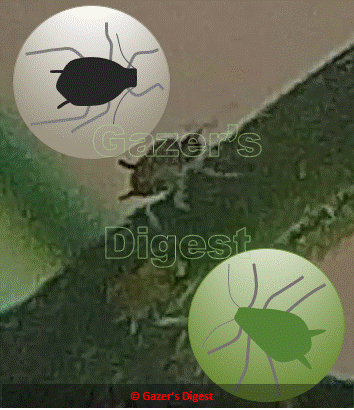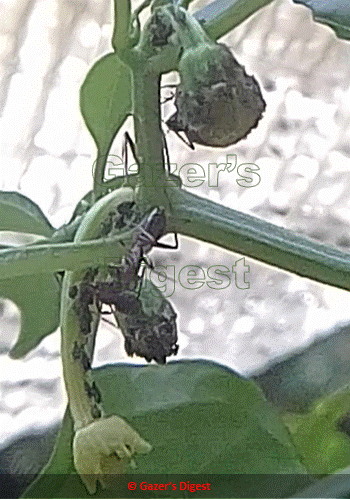PEPPER PLANT FLOWERING BUT NO FRUIT. WHY?
January 9, 2024

This banana pepper plant was covered with a vegetable net sack to protect it from beetles. It produced one banana pepper. However, later, the plant produced flowers but no fruit. I was wondering what went wrong. “Without proper pollination, the plant will not produce fruits”. The plant cover might prevent bees from carrying out their job!
I started to search for insects, and I noticed an ant—about 6 mm long, went through the cover. Then, I noticed a few ants on a leaf of the plant.
I looked through my magnifying glass at the leaves. I noticed tiny odd round black objects attached to the surface of a leaf. They were about 1 mm long creatures. I had never seen these insects before. “Do these insects harm the plant?” These insects had also attached to the surfaces of some flower buds. One of them was seen walking on a stem. “They have the food they need!”. Where did they come from?
Some of the creatures—looked like tiny eggs, on bud surfaces had a badge body, and were about the same size as the black insects. This bug has two tiny pieces—shaped like two tiny sticks, that protrude out from the back end of the bug. They are not eating the leaves but might feed by sucking the sap of the pepper plant.
It looked as if the ants were attracted to the bugs. Why were the ants attracted to the bugs? The bugs' feeding might result in something—a substance which was passed from their bodies; that the ants were attracted to. The ants might feed on the excretion of this bug.
The two kinds of bugs and some ants were interacting. This interaction had badly affected the plant. The plant was losing nutrients that might resulted from the bugs' feeding and the interaction.

The insects were not exposed to predators. In this case, the plant cover seems to have helped them multiply. If the plant is not covered the insects will be exposed to rainfall as well.
During the plant recovery process, the plant was exposed to rainfall. The black insects were clever enough to protect them from exposure to rain.
However, these insects can be removed before they multiply. An infested leaf can simply be pinch off from the plant. Plants can also be recovered by cutting the damaged flower buds and leaves if an infestation is found later.
The images were captured as it was found happening in nature, and not enhanced using software. Images may be subject to copyright.
